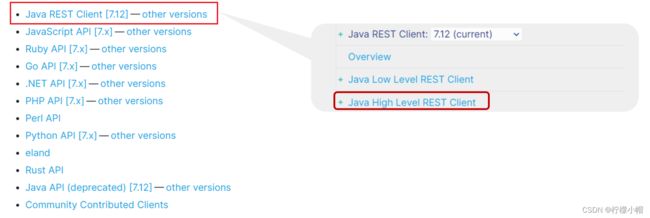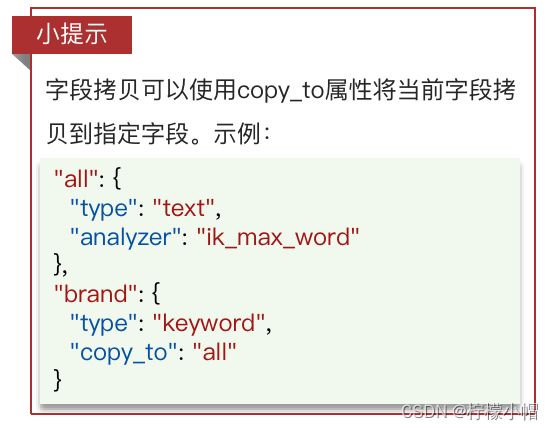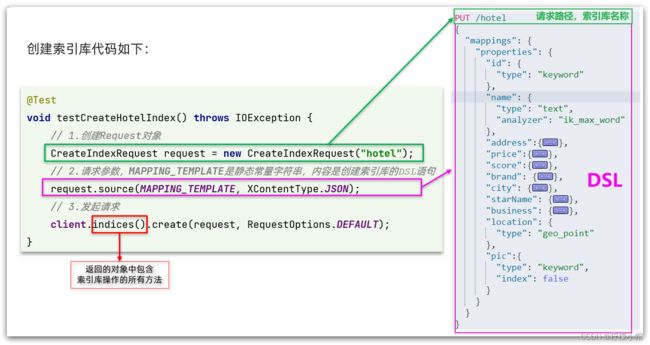SpringCloud 微服务全栈体系(十四)
第十一章 分布式搜索引擎 elasticsearch
四、RestAPI
-
ES 官方提供了各种不同语言的客户端,用来操作 ES。这些客户端的本质就是组装 DSL 语句,通过 http 请求发送给 ES。官方文档地址:https://www.elastic.co/guide/en/elasticsearch/client/index.html
-
其中的 Java Rest Client 又包括两种:
- Java Low Level Rest Client
- Java High Level Rest Client
- 此处使用的是 Java HighLevel Rest Client 客户端 API
1. 导入 Demo 工程
1.1 导入数据
- 导入资料提供的数据库数据:
(见专栏 -> 全栈资料包 -> 资源包/02_cloud)
- 数据结构如下:
CREATE TABLE `tb_hotel` (
`id` bigint(20) NOT NULL COMMENT '酒店id',
`name` varchar(255) NOT NULL COMMENT '酒店名称;例:7天酒店',
`address` varchar(255) NOT NULL COMMENT '酒店地址;例:航头路',
`price` int(10) NOT NULL COMMENT '酒店价格;例:329',
`score` int(2) NOT NULL COMMENT '酒店评分;例:45,就是4.5分',
`brand` varchar(32) NOT NULL COMMENT '酒店品牌;例:如家',
`city` varchar(32) NOT NULL COMMENT '所在城市;例:上海',
`star_name` varchar(16) DEFAULT NULL COMMENT '酒店星级,从低到高分别是:1星到5星,1钻到5钻',
`business` varchar(255) DEFAULT NULL COMMENT '商圈;例:虹桥',
`latitude` varchar(32) NOT NULL COMMENT '纬度;例:31.2497',
`longitude` varchar(32) NOT NULL COMMENT '经度;例:120.3925',
`pic` varchar(255) DEFAULT NULL COMMENT '酒店图片;例:/img/1.jpg',
PRIMARY KEY (`id`)
) ENGINE=InnoDB DEFAULT CHARSET=utf8mb4;
1.2 导入项目
- 导入资料提供的项目:
(见专栏 -> 全栈资料包 -> 资源包/02_cloud)
1.3 mapping 映射分析
-
创建索引库,最关键的是 mapping 映射,而 mapping 映射要考虑的信息包括:
- 字段名
- 字段数据类型
- 是否参与搜索
- 是否需要分词
- 如果分词,分词器是什么?
-
其中:
- 字段名、字段数据类型,可以参考数据表结构的名称和类型
- 是否参与搜索要分析业务来判断,例如图片地址,就无需参与搜索
- 是否分词呢要看内容,内容如果是一个整体就无需分词,反之则要分词
- 分词器,我们可以统一使用 ik_max_word
-
看下酒店数据的索引库结构:
PUT /hotel
{
"mappings": {
"properties": {
"id": {
"type": "keyword"
},
"name":{
"type": "text",
"analyzer": "ik_max_word",
"copy_to": "all"
},
"address":{
"type": "keyword",
"index": false
},
"price":{
"type": "integer"
},
"score":{
"type": "integer"
},
"brand":{
"type": "keyword",
"copy_to": "all"
},
"city":{
"type": "keyword",
"copy_to": "all"
},
"starName":{
"type": "keyword"
},
"business":{
"type": "keyword"
},
"location":{
"type": "geo_point"
},
"pic":{
"type": "keyword",
"index": false
},
"all":{
"type": "text",
"analyzer": "ik_max_word"
}
}
}
}
-
几个特殊字段说明:
- location:地理坐标,里面包含精度、纬度
- all:一个组合字段,其目的是将多字段的值利用 copy_to 合并,提供给用户搜索
-
地理坐标说明:
- copy_to 说明:
1.4 初始化 RestClient
-
在 elasticsearch 提供的 API 中,与 elasticsearch 一切交互都封装在一个名为 RestHighLevelClient 的类中,必须先完成这个对象的初始化,建立与 elasticsearch 的连接。
-
分为三步:
1)引入 es 的 RestHighLevelClient 依赖:
<dependency>
<groupId>org.elasticsearch.clientgroupId>
<artifactId>elasticsearch-rest-high-level-clientartifactId>
dependency>
2)因为 SpringBoot 默认的 ES 版本是 7.6.2,所以我们需要覆盖默认的 ES 版本:
<properties>
<java.version>1.8java.version>
<elasticsearch.version>7.12.1elasticsearch.version>
properties>
3)初始化 RestHighLevelClient:
- 初始化的代码如下:
RestHighLevelClient client = new RestHighLevelClient(RestClient.builder(
HttpHost.create("http://192.168.150.101:9200")
));
- 这里为了单元测试方便,我们创建一个测试类 HotelIndexTest,然后将初始化的代码编写在@BeforeEach 方法中:
package com.alex.hotel;
import org.apache.http.HttpHost;
import org.elasticsearch.client.RestHighLevelClient;
import org.junit.jupiter.api.AfterEach;
import org.junit.jupiter.api.BeforeEach;
import org.junit.jupiter.api.Test;
import java.io.IOException;
public class HotelIndexTest {
private RestHighLevelClient client;
@BeforeEach
void setUp() {
this.client = new RestHighLevelClient(RestClient.builder(
HttpHost.create("http://192.168.150.101:9200")
));
}
@AfterEach
void tearDown() throws IOException {
this.client.close();
}
}
2. 创建索引库
2.1 代码解读
- 创建索引库的 API 如下:
-
代码分为三步:
- 创建 Request 对象。因为是创建索引库的操作,因此 Request 是 CreateIndexRequest。
- 添加请求参数,其实就是 DSL 的 JSON 参数部分。因为 json 字符串很长,这里是定义了静态字符串常量 MAPPING_TEMPLATE,让代码看起来更加优雅。
- 发送请求,client.indices()方法的返回值是 IndicesClient 类型,封装了所有与索引库操作有关的方法。
2.2 完整示例
- 在 hotel-demo 的 com.alex.hotel.constants 包下,创建一个类,定义 mapping 映射的 JSON 字符串常量:
package com.alex.hotel.constants;
public class HotelConstants {
public static final String MAPPING_TEMPLATE = "{\n" +
" \"mappings\": {\n" +
" \"properties\": {\n" +
" \"id\": {\n" +
" \"type\": \"keyword\"\n" +
" },\n" +
" \"name\":{\n" +
" \"type\": \"text\",\n" +
" \"analyzer\": \"ik_max_word\",\n" +
" \"copy_to\": \"all\"\n" +
" },\n" +
" \"address\":{\n" +
" \"type\": \"keyword\",\n" +
" \"index\": false\n" +
" },\n" +
" \"price\":{\n" +
" \"type\": \"integer\"\n" +
" },\n" +
" \"score\":{\n" +
" \"type\": \"integer\"\n" +
" },\n" +
" \"brand\":{\n" +
" \"type\": \"keyword\",\n" +
" \"copy_to\": \"all\"\n" +
" },\n" +
" \"city\":{\n" +
" \"type\": \"keyword\",\n" +
" \"copy_to\": \"all\"\n" +
" },\n" +
" \"starName\":{\n" +
" \"type\": \"keyword\"\n" +
" },\n" +
" \"business\":{\n" +
" \"type\": \"keyword\"\n" +
" },\n" +
" \"location\":{\n" +
" \"type\": \"geo_point\"\n" +
" },\n" +
" \"pic\":{\n" +
" \"type\": \"keyword\",\n" +
" \"index\": false\n" +
" },\n" +
" \"all\":{\n" +
" \"type\": \"text\",\n" +
" \"analyzer\": \"ik_max_word\"\n" +
" }\n" +
" }\n" +
" }\n" +
"}";
}
- 在 hotel-demo 中的 HotelIndexTest 测试类中,编写单元测试,实现创建索引:
@Test
void createHotelIndex() throws IOException {
// 1.创建Request对象
CreateIndexRequest request = new CreateIndexRequest("hotel");
// 2.准备请求的参数:DSL语句
request.source(MAPPING_TEMPLATE, XContentType.JSON);
// 3.发送请求
client.indices().create(request, RequestOptions.DEFAULT);
}
3. 删除索引库
- 删除索引库的 DSL 语句非常简单:
DELETE /hotel
-
与创建索引库相比:
- 请求方式从 PUT 变为 DELTE
- 请求路径不变
- 无请求参数
-
所以代码的差异,注意体现在 Request 对象上。依然是三步走:
- 创建 Request 对象。这次是 DeleteIndexRequest 对象
- 准备参数。这里是无参
- 发送请求。改用 delete 方法
-
在 hotel-demo 中的 HotelIndexTest 测试类中,编写单元测试,实现删除索引:
@Test
void testDeleteHotelIndex() throws IOException {
// 1.创建Request对象
DeleteIndexRequest request = new DeleteIndexRequest("hotel");
// 2.发送请求
client.indices().delete(request, RequestOptions.DEFAULT);
}
4. 判断索引库是否存在
- 判断索引库是否存在,本质就是查询,对应的 DSL 是:
GET /hotel
-
因此与删除的 Java 代码流程是类似的。依然是三步走:
- 创建 Request 对象。这次是 GetIndexRequest 对象
- 准备参数。这里是无参
- 发送请求。改用 exists 方法
@Test
void testExistsHotelIndex() throws IOException {
// 1.创建Request对象
GetIndexRequest request = new GetIndexRequest("hotel");
// 2.发送请求
boolean exists = client.indices().exists(request, RequestOptions.DEFAULT);
// 3.输出
System.err.println(exists ? "索引库已经存在!" : "索引库不存在!");
}
5. 总结
-
JavaRestClient 操作 elasticsearch 的流程基本类似。核心是 client.indices()方法来获取索引库的操作对象。
-
索引库操作的基本步骤:
- 初始化 RestHighLevelClient
- 创建 XxxIndexRequest。XXX 是 Create、Get、Delete
- 准备 DSL( Create 时需要,其它是无参)
- 发送请求。调用 RestHighLevelClient#indices().xxx()方法,xxx 是 create、exists、delete





